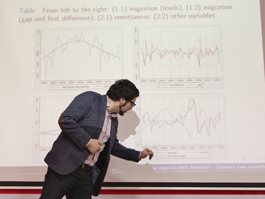On April 7, 2014, ISET hosted Dr. Aleksandr Grigoryan from the American University of Armenia, who presented his paper “Who else emigrates from Armenia? Evidence from intentions”. The paper addressed two main questions: what influences decision making as to whether to migrate? What was the main trend during recent years?
The literature suggests different explanations for the incentives to migrate, like the wage gap between the home country and country of destination or receiving remittances from abroad. Dr. Grigoryan decided to focus on remittances, exploring the relationship between the later and intensions to migrate in Armenia.
In Armenia remittances stand at 25-30% of GDP, depending on external factors. For example, the current conflict in the Crimea could affect the amount of remittances from Russia in the subsequent period. From one point of view remittances stimulate short-run economic growth in the country, however, remittances also signal better opportunities for work and earning in the host county, which give significant incentives for local people to migrate. Dr. Grigoryan emphasized that the presence of a migrant member in a household increases intentions to migrate, which leads to a migration chain.
Another interesting observation was about the positive relationship between work income and the intention to migrate. People with higher work income have higher intentions to migrate abroad. This shows that the reasons for the migration flow from Armenia are not pure economic, they are more social and institutional.
Dr. Grigoryan also discussed many different aspects, including years of education and living conditions in terms of the number of rooms per household. The evidence shows that there is mass migration when migration is perceived as a mass phenomenon, not depending on individual characteristics.
At the end of the presentation Dr. Grigoryan noted that the factors explaining the migration pattern in Armenia are similar for the entire South Caucasus region.











